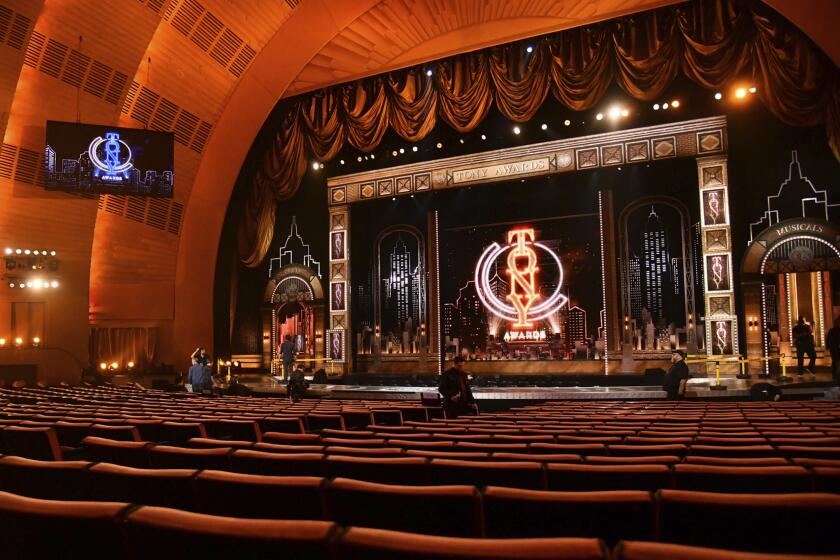LACMA’s New ‘View’ of 19th-Century France : Art: Constant Troyon’s 1837 painting, a gift of the Ahmanson Foundation, goes on view today.
- Share via
“View at La-Ferte-Saint-Aubin, near Orleans,” an 1837 country scene painted by French artist Constant Troyon, has been acquired by the Los Angeles County Museum of Art as a gift of the Ahmanson Foundation. The pastoral landscape, rendered in flickering light and sparkling detail, goes on view today in a gallery of 19th-Century European art in the Ahmanson Building.
The value of the gift was not disclosed, but the painting was auctioned for $708,100--a record for the artist--last summer in Monaco. The foundation subsequently bought the Troyon for the museum from a Swiss dealer.
“I’ve been looking for an important early-19th-Century French picture. They are rather rare on the market, so I was excited to find this one. It really pulls the collection together,” said Philip Conisbee, the museum’s curator of European painting and sculpture.
The large painting, measuring roughly 4 by 6 feet, commands attention as the new focal point of the gallery and offers viewers a feast of freely painted incidents. A placid landscape graced by willowy trees and a forest-like thicket is the setting for a beehive of human activity. Children gather chestnuts, a boy and his dog lounge beside a pond, a woman and child stroll along a winding road, and a pair of lumbermen push a two-man saw through an immense timber, while other characters till the fields and hunt in the forest.
Painted from an actual place but filled with an imaginative composite of everyday activity, the painting portrays “an ideal vision of country life, with none of its hardship,” Conisbee said. But it represents a significant break from the classical idealism and romantic exoticism that had dominated French painting.
Troyon (1810-1865), who was trained in painting at the Sevres porcelain factory, is known as a member of the Barbizon School, named for a village on the edge of the Fontainebleau Forest. The Barbizon painters championed a naturalistic style of landscape painting, which was a precursor to Impressionism.
“View at La-Ferte-Saint-Aubin, near Orleans” was painted when the artist was 27, before he joined the Barbizon group, Conisbee said. “This is one of his earliest landscapes. It was shown at the Salon in Paris in 1837 and again in 1840.” The painting is historically significant because “it shows the very strong influence of (English artist) John Constable on French art of the period,” the curator said, noting that French painters adopted naturalism later than the English. “This is the first time Constable’s influence is so clearly demonstrated,” he said.
Conisbee believes that the Troyon work was inspired by Constable’s “View on the Stour,” now in the collection of the Huntington Library, Art Collections and Botanical Gardens in San Marino. The Constable painting was in Paris from 1824 to 1830 and in a French collection in the 1830s, before it moved to England and later to the United States, he said.
Troyon’s “View” is an important addition to the museum’s collection, Conisbee said. “We have good works by other Barbizon painters (Etienne-Pierre-Theodore Rousseau, Jean Francois Millet and Narcisse-Virgile Diaz) on a small scale. This represents French 19th-Century landscape on a very large scale.”
Previous Ahmanson gifts to the museum have been Old Master works; the Troyon is the first from the 19th Century.
“I think there will be a great deal more interest in pre-Impressionist painting, particularly in the marketplace, now that Impressionist pictures have become so expensive. That will encourage us to look more creatively to the early 19th Century,” Conisbee said, noting that Claude Monet and other Impressionists admired Troyon’s brushwork.
The Troyon acquisition was announced only three weeks after the installation of another Ahmanson Foundation gift, Pedro Berruguete’s massive painting “The Last Supper,” which had required a six-month restoration in the museum’s conservation laboratory. The Troyon canvas, which arrived at the museum two weeks ago and was subsequently approved for purchase, is being put on view promptly because it is in excellent condition, Conisbee said. The landscape had been in the same family in France for more than 100 years before it was sold at auction, he said.
More to Read
The biggest entertainment stories
Get our big stories about Hollywood, film, television, music, arts, culture and more right in your inbox as soon as they publish.
You may occasionally receive promotional content from the Los Angeles Times.










